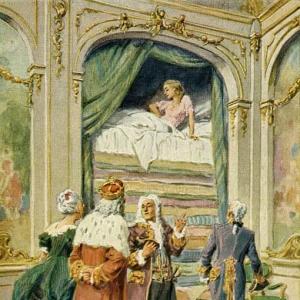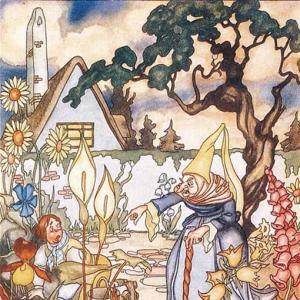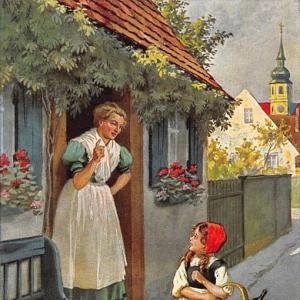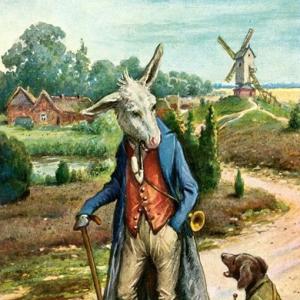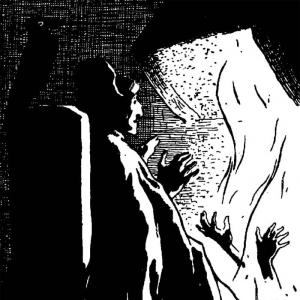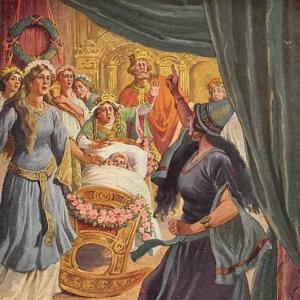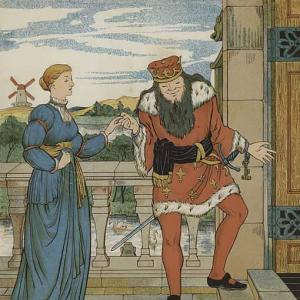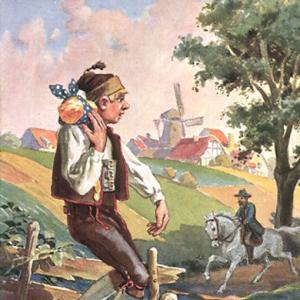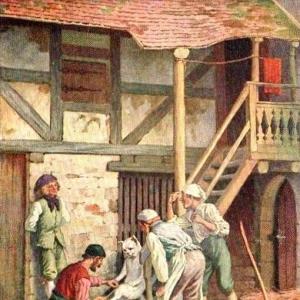Reading time for children: 12 min
You surely remember Ole, the tower watchman. I have told you about two visits I paid him, and now I’ll tell you of a third, although it won’t be the last one.
I have gone up to see him generally on New Year’s Day, but this time it was Moving Day, when everything down in the city streets is very unpleasant, for they are littered with heaps of rubbish and crockery and all kinds of sweepings, not to mention musty old straw that you have to trample about in. Well, there I was, and in the middle of this rubbish from attic and dustbin I saw a couple of children playing going to bed. They thought it looked so inviting there for that game. Yes, they snuggled down in the straw and drew a ragged old scrap of a curtain over them for a quilt. „That was wonderful!“ they said. It was too much for me, so I hurried off to see Ole.
„It’s Moving Day,“ he said. „Streets and alleys are dustbins, dustbins in the grand style; but one cartload is enough for me. I can always find something to pick out of it, and I did that, soon after Christmas. I was walking down the street, a damp, raw, and dirty street, and just the right kind of weather for catching cold. The rubbish man had drawn up his cart there. It was loaded and looked like a sample of Copenhagen streets on Moving Day. In the back of the cart was a fir tree still quite green and with tinsel still hanging on its twigs. It had been the centerpiece of a Christmas display, but now it was thrown out into the street and the rubbish man had stuck it up behind on his pile; a sight to laugh at or weep at – yes, you might even go so far as that – it all depends on your turn of mind. And I thought about it, and so did some of the odds and ends in the cart. At least they may have thought, which is just about the same. Here was a worn lady’s glove. What was it thinking about? Shall I tell you? It lay there pointing its little finger straight at the fir tree. ‚That fir tree touches me,‘ it thought. ‚I have been to a party, too, among the lighted chandeliers. My life was just a night at a ball. A squeeze of the hand, and I burst. That’s all I remember, so now I have nothing more to live for.‘ That’s the way the glove thought, or it may have thought like that. ‚That’s a tasteless thing for that fir tree to do!‘ said the potsherds. But you see, broken crockery finds everything tasteless. ‚When you come to the rubbish cart,‘ they said, ‚it’s time to give up your fine airs and your tinsel. As for ourselves, we’ve been of some use in the world – far more use than an old green stick like that!‘ You see, that was another point of view on the same subject, and many people have it. But still the fir tree looked pretty well, and it was a bit of poetry on the rubbish heap. There are many like that to be found in the streets on Moving Day. But the streets down there were crowded and tiresome, and I longed to get back up to my tower and stay there. So here I sit and look down on them from above, and that’s very amusing.
„Down below the good people are changing houses. They work hard packing up and then go off with their movables, and the house goblin sits on the tail of the cart and moves with them. Household quarrels, family arguments, sorrows, and cares move from the old to the new houses, and so what do they and we get out of it all? Yes, that was told us already long ago, in the good old verse in the newspaper columns:
Remember Death’s great Moving Day! „It is a serious thought, but I hope it is not disagreeable to you to hear about it. Death is the most faithful administrator after all, in spite of his many petty duties. Have you ever thought about them?
„Death is a bus conductor. He is a passport writer. He signs his name to our references; and he is the director of life’s great savings bank. Do you understand that? All our earthly deeds, great and small, are deposited in that savings bank. Then, when Death comes with his Moving Day bus, and we have to get in to be driven to eternity, he gives us our references on the frontier as a passport. For our expense money on the journey he draws from the savings bank one of our deeds, whichever of them most distinctly characterizes our conduct. This may be very pleasant to us, or it may be very horrible!
„Nobody has ever escaped that omnibus journey. They tell stories, indeed, of one man who was not allowed to enter – they call him the Wandering Jew. He still has to run along behind it. If he had managed to get in, he would have escaped the treatment he received from the poets.
„Let’s take an imaginary look into that big Moving Day omnibus. What a mixed group! Side by side sit kings and beggars, the genius and the idiot. On they must go, without goods or wealth, with only their references and their expense money from life’s savings bank. But of each man’s deeds, which one has been found and given to him? Perhaps only a very small one, no bigger than a pea, yet a great blooming vine may grow from it.
„The poor beggar, who sat on a low stool in the corner, and received blows and hard words, perhaps is given the battered stool to take, as a token and as expense money. That stool will become the cart to bear him into eternity, and there it will grow into a throne, gleaming with gold and blooming like an arbor.
„He who was always drinking from the bubbling cup of pleasure, and thus forgetting the wrong things he had done here, receives a wooden keg as his lot. On the journey he has to drink from it; and that pure and cleansing drink will clear his thoughts and awaken his better and nobler nature, so that he sees and feels what before he could not or would not see. Thus he bears within himself his own punishment, the gnawing worm that never dies. If on his wineglass was inscribed Forgetfulness, the inscription on the keg is Memory.
„Whenever I read a good historical book, I cannot help picturing to myself the person of whom I am reading at the final moment of all, when he begins to enter Death’s omnibus. I cannot help wondering which of his deeds Death has given him from the savings bank, and what sort of expense money he will take with him to eternity.
„Once upon a time there was a French king – his name I have forgotten, for the names of good people can sometimes be forgotten by you and me, but it will surely come to light again, because in the time of famine this king became the savior of his people. In his honor they raised a monument of snow, with the inscription, ‚More quickly than this melts did you help us!‘ I think, remembering that monument, that Death must have given him one single snowflake that would never melt but flew like a white butterfly above his royal head, on into the land of eternity.
„Then there was Louis XI – yes, I remember his name. One always remembers what is wicked – a sample of his doings often comes to mind. I wish I could say the story is untrue.
„He had his lord high chancelor beheaded, and that he had a right to do, justly or unjustly; but on the same scaffold he set up the chancelor’s innocent children, the one eight and the other seven, so that they would be spattered with their father’s warm blood. Then they were taken to the Bastille and set in an iron cage, without even a blanket to cover them. Every eighth day the King sent the executioner to them, to pull a tooth from each of them, so that they might suffer even more. The elder said, ‚My mother would die of sorrow if she knew how my little brother suffered. Pray, pull out two of my teeth, and spare him! There were tears in the hangman’s eyes when he heard this, but the king’s will was stronger than the tears. Every eighth day a silver dish, with two children’s teeth on it, was brought to the king; as he had demanded them, so he had them. And I think it was two teeth that Death drew out of life’s savings bank for Louis XI to take with him on his journey to the great land of eternity. They flew before him like two fireflies. They glowed and burned and stung him, the teeth of those innocent children. „Yes, a serious drive it is, that bus drive on the great Moving Day. And when does our turn come?“
„That’s why it’s so very serious; any day, any hour, any minute the bus may come for us. Which of our deeds will Death draw from the savings bank and give us for the journey? Yes, think that over! That Moving Day will not be found on the calendar!“
 Learn languages. Double-tap on a word.Learn languages in context with Childstories.org and Deepl.com.
Learn languages. Double-tap on a word.Learn languages in context with Childstories.org and Deepl.com.Backgrounds
Interpretations
Adaptions
Summary
Linguistics
„Moving Day“ is a lesser-known fairy tale by the renowned Danish author Hans Christian Andersen. Andersen is best known for his timeless classics such as „The Little Mermaid,“ „The Ugly Duckling,“ and „The Emperor’s New Clothes.“ Born on April 2, 1805, in Odense, Denmark, Andersen grew up in poverty but eventually gained fame as a writer, crafting stories that have become beloved by generations of readers.
Andersen’s tales often contain moral lessons, exploring themes of love, loss, and the human condition. His stories typically feature ordinary or downtrodden characters who undergo transformations or face challenging situations. Although many of his tales have a melancholic tone, they often convey a sense of hope and the power of the human spirit.
„Moving Day“ is no exception to this pattern. It is a thought-provoking story that explores themes such as the transience of life, the consequences of our actions, and the inevitability of death. The tale is framed by a conversation between the narrator and Ole, the tower watchman, who provides a unique perspective on life and death as they observe the chaos of Moving Day in the city below. Although the story might not be as well-known as some of Andersen’s other works, it shares the same depth and moral complexity that has made his fairy tales enduring classics.
„Moving Day“ by Hans Christian Andersen can be interpreted on multiple levels:
The transience of life: The story reminds us that life is temporary, and no one knows when their time will come. This uncertainty should encourage us to live mindfully and make the most of our time on Earth.
The consequences of our actions: The story emphasizes that our actions, whether good or bad, have lasting consequences that will follow us into eternity. This concept encourages us to be aware of our actions and strive to make a positive impact on others and the world around us.
The importance of empathy and compassion: The story presents different perspectives on life and death, showing that even small acts of kindness can have a significant impact. This idea encourages readers to be more empathetic and compassionate in their daily lives.
The judgment of character: The story suggests that a person’s true character is revealed in the deeds they leave behind. This concept challenges us to examine our actions and values, ensuring that we live a life that aligns with our moral compass.
The inescapability of death: The story underscores the inevitability of death and the journey into the afterlife. It serves as a reminder to accept the reality of our mortality and make peace with the unknown.
The role of fate: The story implies that we have little control over when death will come for us. This notion invites us to consider the role of fate in our lives and how we can make the best of the time we have.
In summary, „Moving Day“ offers a thought-provoking exploration of life, death, and the consequences of our actions. The story invites readers to reflect on their values and the impact they have on the world, emphasizing the importance of living a compassionate, mindful, and meaningful life.
As „Moving Day“ is not one of Hans Christian Andersen’s more well-known stories, there have been very few adaptations of it in popular culture. However, it is possible that the story has been adapted in some form in regional or lesser-known adaptations.
One potential adaptation of „Moving Day“ is in the form of a children’s book. The simple and humorous nature of the story could make it a good fit for young children, who may enjoy the slapstick antics of Peter and his friends.
Another potential adaptation could be a stage play or puppet show, as the story’s comedic elements and colorful characters could lend themselves well to a theatrical performance. This would also allow for creative interpretation and expansion of the story, as well as the addition of music and other theatrical elements.
Alternatively, „Moving Day“ could be adapted into an animated short film or television episode. The story’s whimsical and lighthearted nature could make it a good fit for an animated adaptation, and the characters and settings could be brought to life through colorful animation and imaginative designs.
Overall, while „Moving Day“ may not be one of Andersen’s most famous tales, there is still potential for creative and engaging adaptations that could introduce the story to new audiences.
In „Moving Day,“ the narrator visits Ole, the tower watchman, on Moving Day, when the city streets are filled with rubbish and chaos as people move their belongings from one house to another. Ole shares his perspective on Moving Day, comparing it to Death’s great Moving Day – the day when a person dies and must face the consequences of their actions in life.
Ole describes Death as a bus conductor, passport writer, and the director of life’s savings bank, where all of a person’s deeds are deposited. When Death’s Moving Day arrives, a person must board the bus to eternity, carrying only their references and one deed – the most characteristic of their life – as expense money. The nature of this deed can either be pleasant or horrible, depending on how they lived their life.
The story then describes various historical figures and the deeds they might have received from Death’s savings bank. For example, an unnamed French king who saved his people during a famine might have been given a never-melting snowflake, symbolizing his quick action to help his subjects. In contrast, Louis XI, who cruelly executed his chancellor and tortured the chancellor’s innocent children, would likely have been given two teeth from those children, which would sting and haunt him in eternity.
Ultimately, the story highlights the importance of considering one’s actions in life, as no one knows when their turn will come to board Death’s Moving Day bus. The consequences of one’s deeds, whether good or bad, will have a lasting impact on their journey into eternity.
The fairy tale „Moving Day“ by Hans Christian Andersen, like many of his works, is rich in allegory and moral introspection. Here’s a linguistic analysis focusing on its themes, narrative style, and symbolism:
Themes
Impermanence and Change: The tale is set on „Moving Day,“ a day of transition and upheaval, symbolizing the inevitable changes and cycles of life. The discarded Christmas tree and the rubbish-strewn streets highlight the theme of impermanence.
Death and Afterlife: Ole, the watchman, introduces a metaphorical „Moving Day“ as Death’s great equalizer. He suggests that everyone, regardless of status, must eventually take the „omnibus journey“ to eternity, carrying only their deeds as currency.
Moral Reckoning: The story suggests that one’s actions in life determine one’s journey into the afterlife. The metaphor of Death choosing deeds from a „savings bank“ underscores the theme of moral accountability.
Narrative Style
Conversational Tone: The narrator recounts his visit to Ole in a conversational, almost casual manner. This style makes deep philosophical themes approachable and relatable.
Reflections and Anecdotes: The tale is structured as a series of reflections and anecdotes, such as the discarded glove and the French king, which illustrate broader moral points.
Imagery and Symbolism: Andersen uses vivid imagery to convey his themes, such as the tinsel-draped fir tree amidst rubbish symbolizing beauty amidst decay. The imagery evokes both the tangible and the spiritual, grounding philosophical concepts in everyday objects.
Symbolism
The Fir Tree: The tree, once beautiful and central to festive celebrations, now lies discarded, symbolizing the fleeting nature of life and beauty.
The Omnibus: Represents the inevitability and universality of death. The diverse group of passengers signifies the equality of all souls in the face of mortality.
Deeds as Currency: Actions in life are imagined as tangible objects in a savings bank, highlighting the lasting impact of one’s moral and ethical choices.
Fireflies and Snowflakes: Serve as metaphors for the haunting memories or virtuous acts that accompany souls into the afterlife, suggesting that remnants of life’s deeds persist in eternity.
Moral
The tale encourages readers to reflect on their lives and consider the legacy of their actions. It suggests an introspective examination of what truly holds value when life’s transient pleasures are stripped away. The story warns against the vanity of materialism and urges an appreciation of moral integrity.
Overall, „Moving Day“ is a narrative steeped in existential contemplation, delivered through Andersen’s unique blend of whimsy and profundity. It asks readers to confront the depths of their conscience in preparation for the inevitable day when transitions from life mirror the upheaval of moving house.
Information for scientific analysis
Fairy tale statistics | Value |
|---|---|
| Translations | EN, ES |
| Readability Index by Björnsson | 29.6 |
| Flesch-Reading-Ease Index | 80.6 |
| Flesch–Kincaid Grade-Level | 6.2 |
| Gunning Fog Index | 9 |
| Coleman–Liau Index | 7.8 |
| SMOG Index | 8.9 |
| Automated Readability Index | 5.9 |
| Character Count | 8.382 |
| Letter Count | 6.455 |
| Sentence Count | 95 |
| Word Count | 1.608 |
| Average Words per Sentence | 16,93 |
| Words with more than 6 letters | 204 |
| Percentage of long words | 12.7% |
| Number of Syllables | 2.072 |
| Average Syllables per Word | 1,29 |
| Words with three Syllables | 93 |
| Percentage Words with three Syllables | 5.8% |



